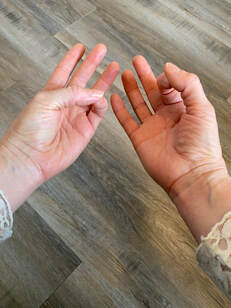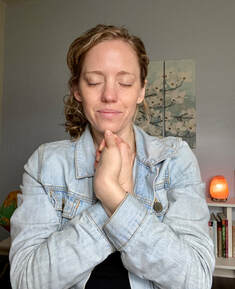 Bilateral stimulation is one of the ways we can help orient ourselves to the present moment and support our nervous system to regulate and ground to create a deeper sense of safety within the body. My favorite bilateral tool to use is called Tip Tap Fingers. This tool can be used to help create space in the mind from triggers and intrusive thoughts. This tool can also help us "keep our lids on" when we feel stressed or triggered. This bilateral brain game can be practiced in the following layers to continue to increase the mental challenge and help build more neuroplasticity in the brain. These tools can help us build resilience and learn to stay checked in with our body for a sense of safety. Tip Tap Fingers:
This past week, I was interviewed by Hannah Levin of Heartfelt Wellbeing where I talk about the practical applications of this tools along with other Yoga for Trauma principles and practices. To see the full interview on Yoga for Trauma, you can click here. For more trauma-informed tools, my Ethics of Trauma-Informed Care training starts on April 29th! You can choose between a live version or self-paced version with lifetime access to the recording. Click here for more information and to reserve a spot today!
0 Comments
 As humans, we are always changing and growing. Using bilateral stimulation is one way to help our brains build new pathways, regulate the vagus nerve and manage stress more effectively. Bilateral healing is utilizing bilateral stimulation through the senses in a rhythmic pattern. Using something that we can hear, see or feel and allowing the brain to process and regulate more effectively. This month I am going to be sharing a series of weekly resources on bilateral healing methods. This week's tool is a bilateral position called The Pretzel (coined by Linda Harrison, LPCS) that when paired with deep rhythmic breathing, can help calm the nervous system and repair the MindBody connection. For a free video of The Pretzel practice, click here. Follow these steps to move into the body position:
It takes 2 minutes for the neurological system to respond by slowing your heart and breath, moving from the sympathetic activated part of your nervous system to the parasympathetic nervous system. Therefore, it is important to rest in this position for at least two minutes. For more trauma-informed resources, you can join my Ethics of Trauma-Informed Care training on April 29th from 9-11 EST! For more information and to reserve your spot, you can click here. |
AuthorWrite something about yourself. No need to be fancy, just an overview. Archives
April 2024
Categories |


 RSS Feed
RSS Feed